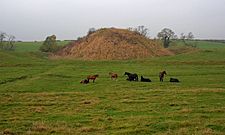Bishopton Castle facts for kids
Quick facts for kids Bishopton Castle |
|
|---|---|
| County Durham, England | |

Surviving motte
|
|
| Coordinates | 54°34′52″N 1°26′07″W / 54.5811°N 1.4353°W |
| Type | Motte-and-bailey |
| Site information | |
| Condition | Earthworks only |
Bishopton Castle was a medieval castle located in the village of Bishopton, County Durham, England. Today, only the earthworks of the castle remain. These earthworks, especially the large mound called a motte, are protected as a Scheduled Ancient Monument. This means they are important historical sites.
Contents
Discovering Bishopton Castle
Bishopton Castle was built in 1143 by a man named Roger de Conyers. It was located in Bishopton village, close to the town of Darlington. The castle was designed as a motte-and-bailey castle. This type of castle has a large earth mound (the motte) with a tower on top. Below the motte is a walled courtyard (the bailey).
Castle Design and Defenses
Unusually, Bishopton Castle had two baileys instead of the usual one. It also had two large areas beyond these baileys. In the 12th century, the castle was surrounded by a shallow, man-made lake. This lake was filled by a nearby stream. The only way to reach the castle was by crossing special raised paths called causeways. These features made the castle very hard to attack.
Why Was the Castle Built?
Roger de Conyers built Bishopton Castle during a disagreement. He supported William of St. Barbara in a dispute over who should be the Bishop of Durham. The Bishop of Durham was a very powerful church leader and landowner in the region. Building a castle helped Roger de Conyers show his strength and support.
Who Owned the Castle Later?
Over time, the castle became the property of the Bishop of Durham. This made the Bishop an even more powerful figure in the area.
Uncovering Castle Secrets
In 2015 and 2016, a project called the Round Mounds Project studied the Bishopton Castle mound. They were looking to see if Norman castle mounds were built on top of older, prehistoric mounds.
What Did They Find?
Scientists took a core sample from the top of the mound down to the original ground. They used Radiocarbon dating on buried materials. This method helps to find out how old something is. Most of the mounds studied, including Bishopton, were built by the Normans. There was no sign of an older earthwork underneath. The study also showed that a raised path on the north side of the castle was added later. It was not part of the original design.


